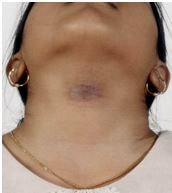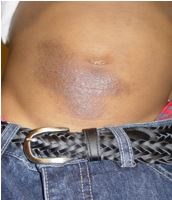Introduction
Nickel allergy is one of the most common causes of allergic contact dermatitis. Nickel is usually found in metal product. Nickel allergy may develop after repeated or prolonged exposure to items containing nickel. The dermatitis (eczema) develops in areas where nickel-containing metal touches the skin. The affected areas become itchy, red and may develop blisters (acute dermatitis) or become dry, thickened and hyperpigmented (chronic dermatitis).
The sites commonly affected are the earlobes (from earrings), the wrists (from watch strap) and the lower abdomen (from jeans stud). Nickel can also be found in many everyday items, such as coins, zippers and spectacle frames.
Nickel allergy can affect people of all ages. Current treatment can reduce the symptoms of nickel allergy. Once a person develops nickel allergy, he or she will always be sensitive to the metal and needs to avoid contact.
Risk factors
Risk factors of developing nickel contact dermatitis include:
- Ear or body piercing.
Nickel is commonly found in jewellery. The more piercings you have, the greater your risk of developing a nickel allergy. - Occupations with contact to metal.
People who have regular exposure to nickel while doing wet work may be more likely to develop nickel allergy. Metalworkers, hairdressers, people who work in certain food industries and domestic cleaners are examples of people at risk of developing nickel allergy. - Female.
Females are more likely to have nickel allergy than males. This may be because females tend to have more piercings and getting exposed at a younger age. - Personal or family history of endogenous eczema.
People with a personal or family history of atopic eczema or discoid eczema are more prone to develop contact dermatitis to nickel. - History of allergy to other metals.
People who have sensitivity to palladium, cobalt or chromium may also be allergic to nickel.
Signs and symptoms
The allergic reaction usually begins within 12 to 48 hours after exposure to nickel. The rash usually appears on the area where the skin comes into contact with nickel but they may appear elsewhere on the body. The signs and symptoms of nickel allergy include:
- Itchiness
- Redness
- Rash or bumps on the skin
- Blisters and weepy areas in acute cases
- Dry patches of skin that may resemble a burn
- Thickened, scaly patches in chronic cases
Where is nickel found?
- Jewellery.
Brooch, earrings, necklaces, bracelets, rings and watch-straps may contain nickel. Gold and silver jewellery should be safe. However, white gold contains nickel. - Clothing.
Trousers/jeans studs, belt buckles, buttons, metal zips, bra hooks, hair-pins and spectacle frames are likely to contain nickel. Use substitutes made of plastic, coated or painted metal or some other material. - Personal items.
Mobile phones, compact powders, handbag handles, lighters, razors, keys, key chains, pocket knives and pens are examples of some personal items that contain nickel. - Coins.
Cashiers with nickel allergy may develop hand dermatitis from this source. - Items at home.
Kitchen utensils, cutlery, toaster, metal teapots, scissors, needles and pins are examples of nickel containing items found at home. Choose tools with plastic handles. Stainless steel does not usually cause dermatitis unless it is nickel-plated. - Items at work.
Nickel dermatitis may be aggravated by contact with paper clips, pens and metal instruments at work. - Food.
Certain food, such as canned food, potatoes, root vegetables, green beans, broccoli, peas, dried fruit, nuts and chocolate has traces of nickel.
How can we make the diagnosis?
Diagnosis can usually be made based on the patient’s history of contact with items that may contain nickel, appearance and the location of the skin lesions.
Patch test can be carried out to confirm the diagnosis. During patch test, small amount of allergens (including nickel) are placed in small chambers and applied to the skin. The patches remain on the skin for two days before the doctor removes them. If you have nickel allergy, the skin under the nickel patch will be inflamed when the patch is removed.
Data from Department of Dermatology, Hospital Kuala Lumpur showed that between the years 2000 to 2012, 19-40% of patients that underwent patch test had positive reaction to nickel.
How to treat nickel dermatitis?
First is to identify the potential source of nickel and avoid it.
The eczema can be managed using emollients, topical steroid and antihistamines. Sometimes, antibiotic may be prescribed if there are signs of infection. Wet compress can help to dry up the blisters and relieve itchiness.
There is no cure for nickel dermatitis. Once you develop sensitivity to nickel, the rash will appear whenever you come in contact with the metal. Once a particular site has reacted to nickel, that site will react even more when re-exposed to nickel.
How to minimize or avoid contact with nickel?
Avoid prolonged exposure to items containing nickel, especially jewellery. However, it is not always easy to avoid nickel because it is present in many products. Home test kits are available to check for nickel in metal items.
The following tips maybe helpful:
- Use jewellery that is nickel free, made of yellow gold, sterling silver or titanium.
- If you wear head cover (tudung), choose one that does not require a brooch
- Look for substitutes for nickel containing items,
e.g. watch strap made of leather, cloth or plastic
zippers or clothing fasteners made of plastic or coated metals
plastic or titanium spectacles frames - Stick to wooden, plastic and nickel free items in the kitchen
- Do not keep loose change in pocket, use a coin purse
- Create a barrier,
e.g. wear gloves if you are in contact with nickel containing items such as coins
cover metal buttons/studs with cloth
use clear nail varnish on your favourite costume jewellery if you have to wear it
 |
 |
|
| Figure 1: Contact dermatitis due to brooch containing nickel | Figure 2: Contact dermatitis due to nickel (metal buckle and jeans stud) |
| Last Reviewed | : | 27 January 2014 |
| Writer | : | Dr. Azura bt. Mohd Affandi |







